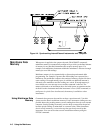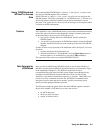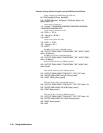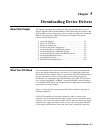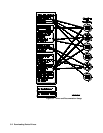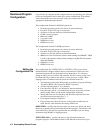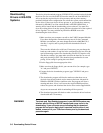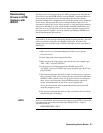
1
Memory
Configuration
Before attempting to download any device drivers you should understand how
memory is affected when you specify a size for one or more types of RAM.
There are three types of RAM that you can allocate in the mainframe:
• RAM disk (RDISK)
• Non-volatile RAM (NRAM)
• Driver RAM (DRAM)
Figure 5-2 shows the positioning of these areas in memory. User Non-volatile
RAM and RAM Disk both occupy higher memory addresses than the Driver
RAM. Because the actual size of these three areas is variable, they do not have a
fixed starting position. At creation time, the lowest unused memory address
becomes the starting address for the requested type of RAM. Memory areas set
at higher addresses can be created without affecting any previously created
lower memory areas, but creating a new memory area causes any areas above it
to be removed.
NOTE If you wish to use RDISK or NRAM, you can modify the configuration file so
that the download program sets up the required memory segments.
Example If you create a RAM Disk area without creating any User Non-volatile RAM or
Driver RAM, the starting address for the RAM Disk will be at the lowest address
(F80000
h
for a command module with 512Kbytes of memory). If you now create a
Driver RAM area, the RAM Disk area will be removed since the new area has to be
at a lower address then the RAM Disk area.
FFFFFF
h
System Non-volatile
Instrument Memory
Operating System memory
RAM Disk
Non-volatile User RAM
Low Memory
Driver RAM
The Low Address depends on the amount of memory installed. It is equal to the highest address
plus 1 (1000000
h
) minus the size of memory installed. The boot time messages will tell you how
much RAM you have installed in your system. In a system with 512Kbytes of memory the Low
Address is low address = 1000000
h
- 80000
h
= F80000
h
, or 16,252,928 decimal.
Figure 5-2. Positioning of Allocatable RAM
Downloading Device Drivers 5-3




